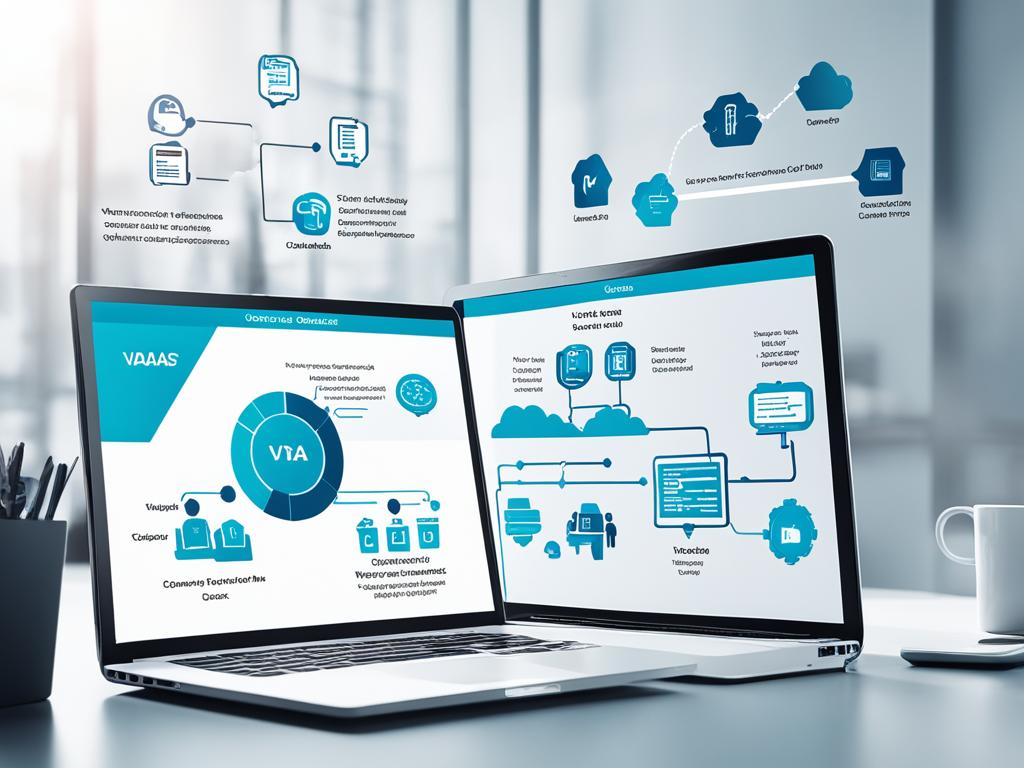In 2020, the COVID-19 pandemic made every business go remote quickly. This big change has changed how we work for good. Now, over 74% of workers say they’re more likely to stay with their jobs if they can work from home.
Today, workers want to work from anywhere, not just one place. That’s where DaaS (Desktop as a Service) and WaaS (Workspace as a Service) come in. These cloud services give workers secure access to their desktops from anywhere, on any device.
IaaS: Infrastructure as a Service (IaaS) is a cloud computing model that provides users with virtualized computing resources, such as servers, storage, and networking. IaaS allows organizations to provision and manage their own infrastructure, giving them greater control over their IT environment. With IaaS, companies can scale up or down as needed, without the need for expensive hardware upgrades or new equipment purchases.
PaaS: Platform as a Service (PaaS) is a cloud computing model that provides users with a complete development and deployment environment for building, testing, and running applications. PaaS includes tools such as integrated development environments (IDEs), databases, and middleware, allowing developers to focus on writing code rather than managing infrastructure. With PaaS, organizations can quickly deploy and scale their applications without worrying about the underlying infrastructure.
SaaS: Software as a Service (SaaS) is a cloud computing model that provides users with access to software applications over the internet. SaaS eliminates the need for organizations to install, configure, and maintain software on their own devices or servers. With SaaS, companies can use the latest versions of software without the hassle of updates and maintenance, allowing them to focus on their core business activities.
MBaaS: Backend as a Service (MBaaS) is a cloud computing model that provides developers with access to backend infrastructure for building mobile apps. MBaaS provides services such as user authentication, data storage, and push notifications, allowing developers to focus on the front-end of their applications without worrying about the underlying complexity. With MBaaS, organizations can quickly deploy and scale their mobile apps without the need for expensive IT infrastructure or expertise.
BaaS (Backup as a Service): Secure Cloud Storage: In today’s digital age, data backup and recovery are crucial components of any organization’s IT strategy. Backup as a Service (BaaS) provides a secure and reliable way to store and manage backups in the cloud. With BaaS, users can rest assured that their critical data is safely stored offsite, ready to be restored in case of a disaster or data loss. By leveraging BaaS, organizations can eliminate the need for expensive on-premise storage solutions and enjoy greater flexibility, scalability, and cost savings.
Cloud solutions are a collection of cloud computing models that provide users with access to a wide range of services, including IaaS, PaaS, SaaS, and BaaS. Cloud solutions allow organizations to customize their computing environment to meet specific business needs, providing flexibility, scalability, and cost savings. With cloud solutions, companies can quickly deploy and scale their applications, collaborate in real-time, and access critical data from anywhere.
Key Takeaways
- DaaS and WaaS offer remote access to business resources, independent of location.
- DaaS and WaaS provide features such as performance, reliability, security, and scalability due to their cloud-hosted architecture.
- The adoption of DaaS and WaaS leads to significant cost savings by avoiding heavy servers, individual desktops, and expensive hardware.
- Virtual desktop solutions enable businesses to scale their desktops up or down as needed, reducing unnecessary costs.
- DaaS frees up IT staff to focus on critical projects by centralizing data storage and managing backups efficiently.
What is DaaS (Desktop as a Service)?
DaaS is a cloud-based way to give employees secure access to desktops from anywhere. It’s a new way to use computers where a cloud service takes care of all the hard work. This includes storage, computing, and networking, and even the virtual machines that run the desktops.
Defining Desktop as a Service
With DaaS, people can get to their desktops, apps, and data using software or a web browser. The cloud sends the desktops from a big server. This means no need for hardware or software at the office, making it easy and cheap for businesses.
How DaaS Works
DaaS uses cloud IaaS, PaaS, and SaaS to give users a full desktop experience. The cloud service takes care of the backend stuff like virtual machines and storage. This lets companies focus on their work, not IT stuff.
DaaS makes working from home easy. It lets IT teams move data around and gives users access to data from anywhere. Using the cloud, DaaS keeps data safe from threats with strong security at remote data centers.
Benefits of Adopting Desktop as a Service
Desktop as a Service (DaaS) is getting more popular. It offers many benefits for companies. These include better access, flexibility, saving money, and growing as needed. DaaS is changing how businesses handle their IT setup.
Accessibility and Flexibility
DaaS lets workers use their own devices for work. They can access important apps and data from anywhere. This means they can work from home or anywhere else.
It helps workers stay productive and work together, even when they’re not in the office.
Cost Savings
DaaS helps companies save money with BYOD (Bring Your Own Device). It cuts down on costs for setting up, updating, and managing devices. It also means no need for big servers or expensive hardware.
Scalability on Demand
DaaS can grow or shrink as a company needs. This means companies can quickly add or remove desktops. It’s great for fast-changing businesses today.
The use of DaaS has grown a lot with more people working from home during the pandemic. It’s now one of the top trends in IaaS, PaaS, SaaS, BaaS, and Cloud Solutions. As companies look to make IT easier and give workers more freedom, DaaS is set to be key in the future of work.
DaaS vs Traditional VDI
Organizations have two main choices for virtual desktops: Desktop as a Service (DaaS) and Virtual Desktop Infrastructure (VDI). VDI makes the organization build and manage the virtual desktop on its own. DaaS is cloud-based. A third-party provider takes care of the setup and upkeep.
DaaS has a big advantage over traditional VDI. It doesn’t need a big upfront cost. You pay as you go, which is good for small businesses. This way, you don’t spend a lot on hardware and IT.
DaaS also offers more flexibility and scalability. The cloud provider takes care of updates, security, and maintenance. This lets businesses focus on what they do best, not IT stuff.
| Feature | DaaS | Traditional VDI |
|---|---|---|
| Deployment | Quick and easy, no on-premises infrastructure required | Requires significant IT resources and on-premises hardware |
| Management | Handled by the cloud provider, reducing IT workload | Requires in-house IT expertise to manage the entire environment |
| Cost | Subscription-based, shifting from CapEx to OpEx | Higher upfront costs for hardware, software, and IT resources |
| Scalability | Easily scale up or down as needed | Requires planning and investment to scale the infrastructure |
| Security | Providers offer robust security measures, but organizations must ensure compliance | Organizations are responsible for the entire security posture |
Choosing Cloud Solutions for virtual desktops means looking at the pros and cons of VDI and DaaS. The best choice depends on what the organization needs, its budget, and its IT skills.

Key Features of Desktop as a Service
Modern Desktop as a Service (DaaS) solutions focus on security and easy access. They tackle security issues with strong network checks and 256-bit encryption. This lets people work from anywhere with secure access to company data and tools.
High-level Data Security
DaaS keeps data safe with strong security steps. It uses multi-factor authentication, full encryption, and top-notch threat spotting. This keeps data and apps safe in the cloud, reducing risks from old desktop setups.
Broader Accessibility Across Devices
DaaS lets users get to their work from any device, like desktops, laptops, tablets, or phones. This means people can work from anywhere, not just from one spot. It makes working together and staying productive easier, thanks to cloud tech.
| DaaS Feature | Benefit |
|---|---|
| High-level Data Security | Robust security protocols, end-to-end encryption, and advanced threat detection to safeguard sensitive data and applications. |
| Broader Accessibility Across Devices | Enables remote and mobile access to personalized desktops, applications, and data from any device, promoting a flexible and collaborative workforce. |
Cloud Solutions, IaaS, PaaS, and SaaS are getting more popular. DaaS is a top choice for companies wanting to update their desktops and help their workers. With BaaS, DaaS offers a full package of security, easy access, and flexibility. This helps companies do well in the digital world.
DaaS (Desktop as a Service) Deployment Models
In cloud computing, DaaS offers two main ways to deploy: persistent and non-persistent desktops. Knowing the differences helps businesses pick the best fit for their needs.
Persistent Desktops
Persistent desktops let users customize their virtual workspaces. They keep the same look and feel every time a user logs in. This makes the desktop feel like home for users.
These desktops are great for those who need a lot of personal touches. They’re perfect for workers who use their desktops a lot and need everything just so.
Non-Persistent Desktops
Non-persistent desktops reset to their default state after each use. They don’t keep user settings or data. This makes them good for workers who don’t need a custom desktop.
This type is also cheaper because it uses less cloud storage. It’s often used in places like customer service or training where a custom desktop isn’t needed.
Choosing between persistent and non-persistent desktops depends on what the company needs. Things like user needs, budget, and the type of work should guide the choice.
Use Cases for Adopting DaaS Solutions
Desktop as a Service (DaaS) changes how companies handle their IT setup. It uses Cloud Solutions to help businesses of all sizes. Here are some main ways DaaS can help:
- Enabling Secure Remote Work: With more people working from home, DaaS offers a safe way to work online. It keeps work going even when things get tough.
- Facilitating BYOD Initiatives: DaaS makes it easy to use your own device at work. It gives employees access to their work from any device. And it keeps data safe with strong IaaS, PaaS, and SaaS security.
- Supporting Contractors and Partners: DaaS is great for companies that work with many contractors and remote teams. It gives them safe access to company tools without needing a lot of IT setup.
- Enhancing Contact Center Operations: DaaS helps call centers by giving agents virtual desktops with the apps they need. This cuts down on costs for keeping up with hardware and software.
- Providing Desktops and PC Refreshes: DaaS is perfect for companies that often update desktops and PCs. It helps remote and branch office workers, and field workers, use less power and create less waste. This is good for the planet and cuts down on carbon emissions.
By using DaaS, companies can make their IT better, work more efficiently, and deliver better services. They get to enjoy the benefits of Cloud Solutions, like being able to grow, change, and save money.

Challenges and Considerations with DaaS
Desktop as a Service (DaaS) has many benefits like better access, growth, and saving money. But, there are challenges and things to think about when using DaaS. A key need for DaaS is a strong and fast internet connection.
Internet Connectivity Requirements
DaaS needs a stable and quick internet to work well. This can be hard for teams working from home or in places with bad internet. Slow or unreliable internet can make users unhappy, causing delays and less work done.
A study found 68% of people were happy with how DaaS grew in their company. But, security issues with cloud data were the top challenge for DaaS (46%). Companies should look at their internet setup and think about how it might affect their DaaS use.
| Statistic | Percentage |
|---|---|
| Most commonly used DaaS tool: Azure Virtual Desktop | 62% |
| Respondents who adopted DaaS due to IT lacking VDI skills | 54% |
| Respondents most satisfied with DaaS scalability | 68% |
| Respondents who identified cloud data security as a challenge | 46% |
Aside from internet issues, companies must think about laws, costs, and the chance of spending more over time. By looking at these points, businesses can make smart choices and use DaaS to change their workspaces and help their remote teams.
Top DaaS Providers and Vendors
The cloud has changed how businesses handle their IT needs. Now, Desktop-as-a-Service (DaaS) is a key solution. Big names like Microsoft Azure, VMware’s Horizon cloud on Azure, VMC on AWS, and Amazon Web Services offer strong DaaS options. These meet the needs of companies wanting to update their workspaces.
Anunta is a top DaaS provider known for its full-service cloud desktop solutions. They help clients worldwide with their cloud-hosted desktop needs. Anunta offers managed Windows Virtual Desktop (WVD), managed Horizon Desktop, and managed Citrix Desktop. This ensures easy integration and support for any business size.
| DaaS Provider | Pricing Model | Key Features |
|---|---|---|
| Amazon WorkSpaces | Monthly or hourly pricing | Cloud-hosted virtual desktops, scalable resources, secure remote access |
| Citrix Managed Desktops | Varies based on service type and contract length | Virtualized applications and desktops, comprehensive management, enterprise-grade security |
| Cloudalize | Subscription starting at $0.89/hour plus $19.99/month | Flexible and scalable virtual desktops, cloud-based collaboration, data protection |
| dinCloud dinWorkspace | Minimum 5 seats, monthly pricing | Hosted virtual desktops, unified communications, cloud storage integration |
| Evolve IP | Minimum 12-month term, 25 seats | Customizable virtual desktops, managed IT services, disaster recovery options |
| itopia Cloud Automation Stack (CAS) | Minimum 12 months, 5-10 VMs, hourly billing | Automated desktop provisioning, cloud-based management, seamless scalability |
These leading IaaS, PaaS, SaaS, BaaS, and Cloud Solutions providers offer many DaaS options. They help businesses streamline their IT, improve remote work, and use cloud desktop solutions.
Conclusion
Desktop as a Service (DaaS) is changing the way we work. It helps the modern workforce and drives digital change in companies. With cloud services like IaaS, PaaS, SaaS, and BaaS, DaaS gives workers secure access to their desktops and important apps anywhere, anytime.
DaaS has many benefits. It offers more flexibility, saves money, and grows with your business. It also makes data safer and IT easier to manage. By using DaaS, companies can focus more on their main goals.
If you need to support remote workers, make IT simpler, or protect data better, DaaS is a great choice. It’s flexible and can grow with your business. Think about how DaaS can change your workplace for the better.
Source Links
- https://www.acecloudhosting.com/blog/waas-vs-daas/ – Workspace As a Service Vs. Desktop as a Service: Choose A Right Desktop Solution
- https://www.nutanix.com/info/desktop-as-a-service-daas – What is Desktop-as-a-Service (DaaS)?
- https://www.acldigital.com/blogs/navigating-landscape-desktop-service-daas-challenges-and-considerations – Desktop as a Service (DaaS): Challenges and Considerations | Blog
- https://azure.microsoft.com/en-us/blog/what-is-desktop-as-a-service-daas-and-how-can-it-help-your-organization/ – What is desktop as a service (DaaS) and how can it help your organization? | Microsoft Azure Blog
- https://www.techtarget.com/searchvirtualdesktop/definition/desktop-as-a-service-DaaS – What is desktop as a service (DaaS)? | Definition from TechTarget
- https://www.ninjaone.com/it-hub/it-service-management/what-is-desktop-as-a-service-daas/ – What Is Desktop as a Service (DaaS)? | NinjaOne
- https://www.evolveip.net/blog/top-desktop-as-a-service-daas-benefits – Top 8 Desktop as a Service (DaaS) Benefits | Evolve IP
- https://www.acecloudhosting.com/blog/desktop-as-a-service-daas-benefits/ – Benefits of DaaS: Why are Managed Desktop as a service Solutions Dominating the SME Market in 2023?
- https://blogs.vmware.com/euc/2022/09/vdi-vs-daas-which-is-better-for-your-virtual-desktop-and-app-environment.html – VDI vs. DaaS: Which is better for your virtual desktop and app environment?
- https://www.ironorbit.com/desktop-as-a-service-daas-vs-virtual-desktop-infrastructure-vdi/ – Desktop as a Service (DaaS) vs. Virtual Desktop Infrastructure (VDI) – IronOrbit
- https://community.spiceworks.com/t/vdi-vs-daas/700703 – VDI vs DaaS?
- https://www.evolveip.net/blog/what-is-daas-desktop-as-a-service – What Is DaaS? (Desktop-as-a-Service?)
- https://www.ibm.com/topics/desktop-as-a-service – What Is Desktop as a Service (DaaS)? | IBM
- https://phoenixnap.com/blog/desktop-as-a-service-daas – What Is DaaS (Desktop as a Service)? | phoenixNAP Blog
- https://community.citrix.com/tech-zone/learn/tech-briefs/daas/ – Tech Brief: Citrix Desktops-as-a-Service (DaaS)
- https://bluexp.netapp.com/blog/cvo-blg-desktop-as-a-service-daas-how-to-choose-the-right-solution – Desktop as a Service (DaaS): How to Choose the Right Solution
- https://www.acecloudhosting.com/blog/use-cases-for-desktop-as-a-service/ – Top 10 Use Cases for Desktop as a Service
- https://www.cloud4c.com/solutions/desktop-as-a-service-daas – Fully Managed Desktop-as-a-Service Offerings | Advanced Cloud MSP
- https://www.gartner.com/peer-community/oneminuteinsights/desktop-service-daas-nrp – Desktop as a Service (DaaS) | Gartner Peer Community
- https://www.cmswire.com/information-management/what-is-daas-desktop-as-a-service/ – What Is DaaS? Definition, Benefits & Challenges
- https://www.techrepublic.com/article/top-daas-providers/ – Top 6 Desktop as a Service (DaaS) Providers | TechRepublic
- https://slashdot.org/software/desktop-as-a-service-daas/ – Top Desktop as a Service (DaaS) Providers in 2024
- https://www.iistech.com/blog/the-benefits-of-desktop-as-a-service-daas – The Benefits of Desktop as a Service (DaaS)
- https://www.apporto.com/unlock-the-benefits-of-desktop-as-a-service – Unlock the benefits of Desktop as a Service
- https://zeetim.com/what-is-desktop-as-a-service-daas/ – Understanding DaaS: The Complete Guide
